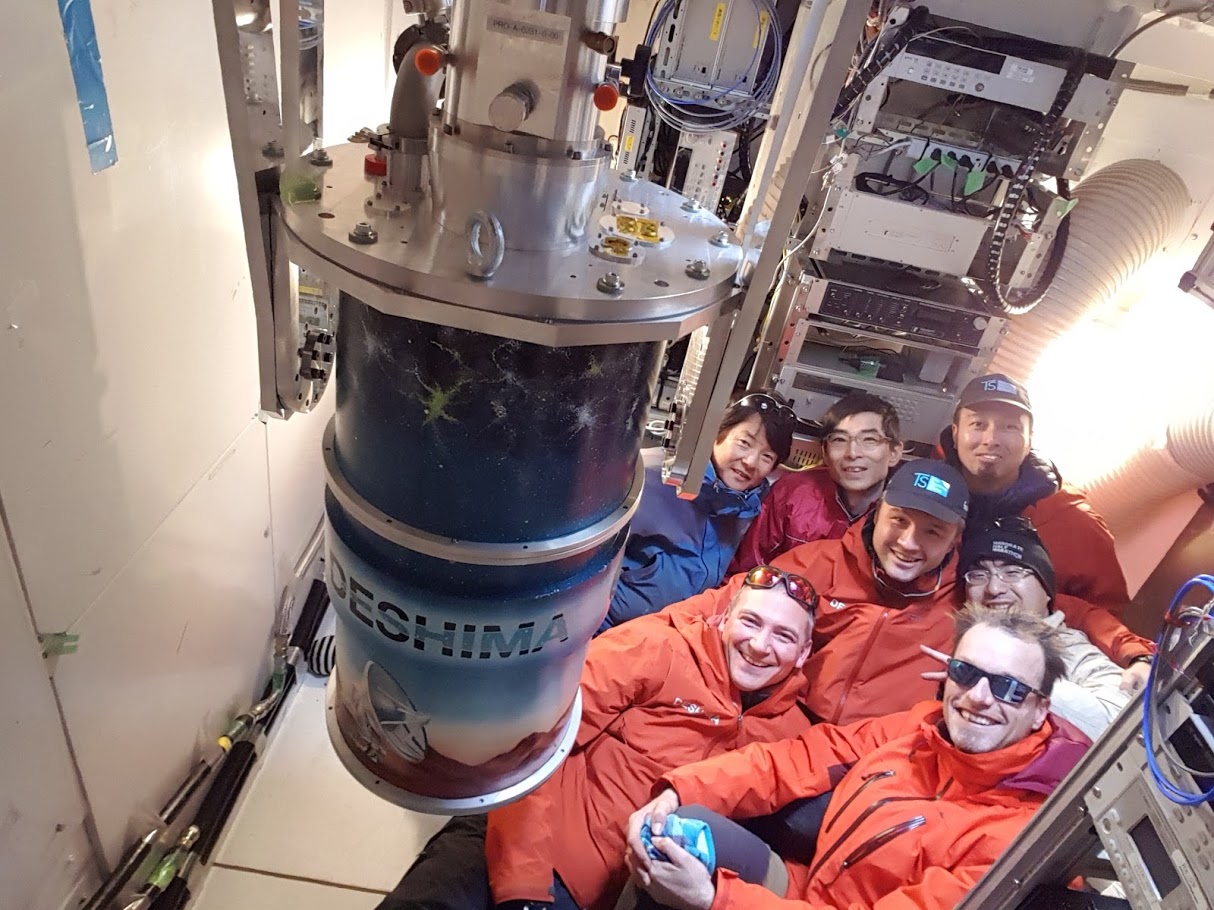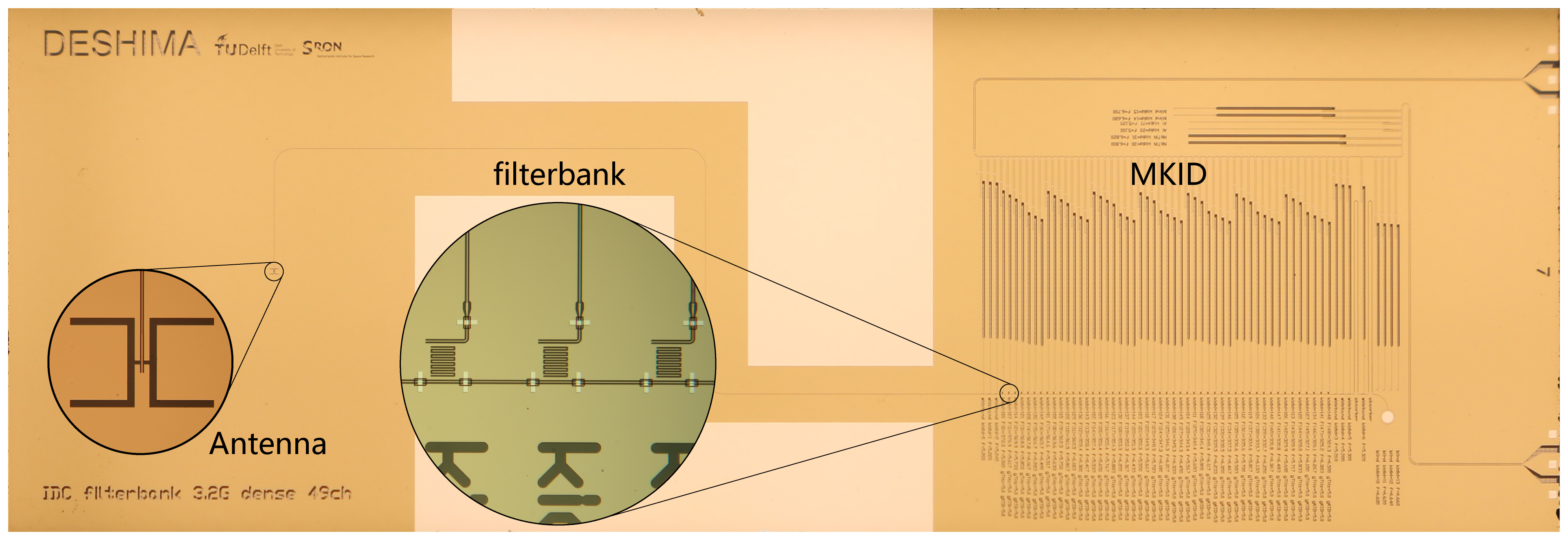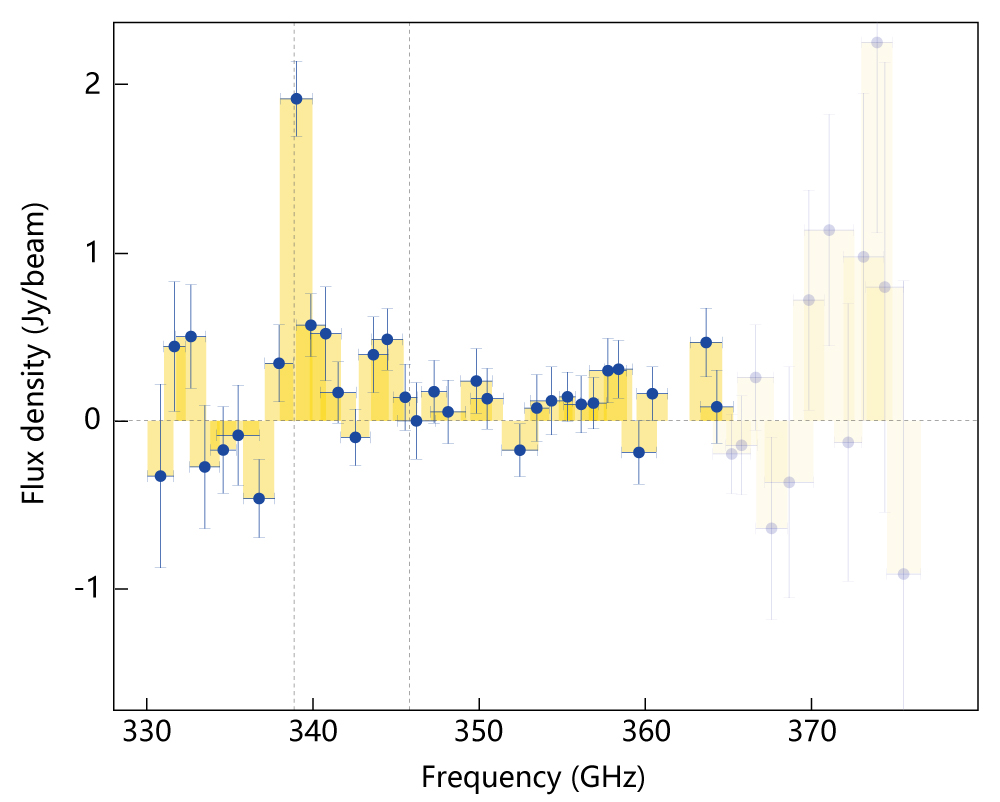Researchers in Japan and the Netherlands jointly developed an originative radio receiver DESHIMA (Deep Spectroscopic High-redshift Mapper) and successfully obtained the first spectra and images with it. Combining the ability to detect a wide frequency range of cosmic radio waves and to disperse them into different frequencies, DESHIMA demonstrated its unique power to efficiently measure the distances to the remotest objects as well as to map the distributions of various molecules in nearby cosmic clouds.

The proud team after mounting the DESHIMA instrument on the ASTE telescope of the National Astronomical Observatory of Japan (NAOJ) in Chile’s Atacama Desert. From left to right, (back row): Toshihiko Kobiki, Tai Oshima (NAOJ), Kenichi Karatsu (TUdelft); (front row): David Thoen, Akira Endo, Robert Huiting (TUdelft), Tatsuya Takekoshi (The University of Electro-Communications, Japan)
Photograph credit: Robert Huiting (SRON)
"Deshima" (or, Dejima) was a Dutch trading post in Japan built in the mid-17th century. For 200 years, Deshima was Japan’s precious window to the world. Now, the two friendly nations open up another window to a new world, the vast Universe, with innovative nanotechnology.
"DESHIMA is a completely new type of astronomical instrument with which a 3D map of the early Universe can be constructed," said Akira Endo, a researcher at the Delft University of Technology and the leader of the DESHIMA project.
The uniqueness of DESHIMA is that it can disperse the wide frequency range of radio waves into different frequencies. DESHIMA’s instantaneous frequency width (332 - 377 GHz) is more than five times wider than that of the receivers used in the Atacama Large Millimeter/submillimeter Array (ALMA).
Dispersing the cosmic radio waves in different frequencies, or spectroscopy, is an important technique to extract various information about the Universe. Since different molecules emit radio waves in different frequencies, spectroscopic observations tell us the composition of the celestial objects. Also, the cosmic expansion decreases the measured frequencies, and measuring the frequency shift from the native frequency provides us the distances to remote objects.
"There are many existing radio receivers with spectroscopic capability, however, the covered frequency range in one observation is quite limited," says Yoichi Tamura, an associate professor at Nagoya University. "On the other hand, DESHIMA achieves an ideal balance between the width of frequency range and spectroscopic performance."
Behind this unique capability is the innovative nanotechnology. The research team developed a special superconducting electric circuit, a filterbank, in which radio waves are dispersed into different frequencies, like a sorting conveyor in a fulfillment center. At the end of the "signal conveyors," sensitive Microwave Kinetic Inductance Detectors (MKID) are located and detect the dispersed signals. DESHIMA is the world's first instrument to combine these two technologies on a chip to detect radio waves from the Universe.

Microscope photo of the DESHIMA chip. Radio signals collected by the telescope are injected into the on-chip antenna (on the left) and propagate to the right-hand side through the thin metal line. A filterbank is located along the line and signals with specific frequencies are extracted by each filter. The signal then enters the MKID and is detected. The size of the chip is 4 cm x 1.5 cm.
Credit: Delft University of Technology
As its first test observation, DESHIMA was installed on a 10-m submillimeter telescope, the Atacama Submillimeter Telescope Experiment (ASTE) operated by the National Astronomical Observatory of Japan (NAOJ) in Northern Chile. The first target was the active galaxy VV 114. The distance to the galaxy has been already measured to be 290 million light-years. DESHIMA successfully detected the signal from the carbon monoxide (CO) molecules in the galaxy at the right frequency expected from the expansion of the Universe.
When astronomers try to detect radio emission from a remote object with unknown distance, usually they sweep a certain range of frequency. Using conventional radio receivers with narrow bandwidth, they need to repeat observations while slightly shifting the frequency. By contrast, the wide-band DESHIMA greatly improves the efficiency of the emission search and helps researchers to produce maps of distant galaxies.
DESHIMA's high performance has also been proven for observations of nearby molecular clouds. DESHIMA simultaneously captured and imaged the distribution of the emission signals from three molecules, CO, formyl ion (HCO+), and hydrogen cyanide (HCN) in the Orion nebula.

Spectrum of the galaxy VV 114 obtained with ASTE. Emission from CO molecules is clearly detected at 339 GHz, which is slightly shifted from its original frequency of 345 GHz due to the cosmic expansion.
Credit: DESHIMA Project Team/Endo et al.

Distribution of CO, HCN, and HCO+ molecules in the Orion nebula. Thanks to its wide frequency range, DESHIMA can detect these three molecular lines simultaneously to obtain these maps with one observation.
Credit: DESHIMA Project Team/Endo et al.
The research team is aiming to further improve the capability of DESHIMA. "Our goal is to expand the frequency width, improve sensitivity, and develop a radio camera with 16 pixels," said Kotaro Kohno, a professor of The University of Tokyo. "The future DESHIMA will be an important point of departure in various astronomy fields."
Note 1. ASTE is located at an altitude of 4860 m above sea level in the Atacama Desert, close to the site of ALMA. Atacama’s clear sky is a great fit for submillimeter wave observations.
Paper and Research Team
This research result is published as A. Endo et al. “First light demonstration of the integrated superconducting spectrometer” in Nature Astronomy on August 5, 2019.
The research team members are:
Akira Endo (Delft University of Technology), Kenichi Karatsu (Delft University of Technology) , Yoichi Tamura (Nagoya University), Tai Oshima (NAOJ/SOKENDAI), Akio Taniguchi (Nagoya University), Tatsuya Takekoshi (The University of Tokyo/The University of Electro-Communications), Shin’ichiro Asayama (NAOJ), Tom J. L. C. Bakx (Nagoya University/NAOJ/Cardiff University), Sjoerd Bosma (Delft University of Technology), Juan Bueno (SRON), Kah Wuy Chin (NAOJ/The University of Tokyo), Yasunori Fujii (NAOJ), Kazuyuki Fujita (Hokkaido University), Robert Huiting (SRON), Soh Ikarashi (Delft University of Technology), Tsuyoshi Ishida (The University of Tokyo), Shun Ishii (NAOJ/Joint ALMA Observatory), Ryohei Kawabe (NAOJ/SOKENDAI/The University of Tokyo), Teun M. Klapwijk (Delft University of Technology/Moscow State Pedagogical University), Kotaro Kohno (The University of Tokyo), Akira Kouchi (Hokkaido University), Nuria Llombart (Delft University of Technology), Jun Maekawa (NAOJ), Vignesh Murugesan (SRON), Shunichi Nakatsubo (JAXA), Masato Naruse (Saitama University), Kazunari Ohtawara (NAOJ), Alejandro Pascual Laguna (SRON/Delft University of Technology), Junya Suzuki (KEK), Koyo Suzuki (Nagoya University), David J. Thoen (Delft University of Technology), Takashi Tsukagoshi (NAOJ), Tetsutaro Ueda (Nagoya University), Pieter J. de Visser (SRON), Paul P. van der Werf (Leiden University), Stephen J. C. Yates (SRON), Yuki Yoshimura (The Univeristy of Tokyo), Ozan Yurduseven (Delft University of Technology), and Jochem J. A. Baselmans (SRON)
This research was supported by:
Netherlands Organization for Scientific Research NWO (Vidi grant No. 639.042.423, NWO Medium Investment grant No. 614.061.611 DESHIMA), the European Research Counsel ERC (ERC-CoG-2014 - Proposal no 648135 MOSAIC), JSPS KAKENHI (Nos. JP25247019, JP17H06130), JSPS Program for Advancing Strategic International Networks to Accelerate the Circulation of Talented Researchers (Program No. R2804), Grant for Joint Research Program of the Institute of Low Temperature Science, Hokkaido University, NAOJ-ALMA Scientific Research Grant Numbers 2018-09B, NWO (Veni Grant 639.041.750), ERC Advanced Grant No. 339306 (ME605 TIQUM)、the Russian Science Foundation (Grant No. 17-72-30036), ERC (Starting Grant No. 639749)、the European Unions Horizon 2020 research and innovation program under grant agreement No 730562 (RadioNet), and the European Union Seventh Framework Programme (FP7/2007-2013,FP7/2007-2011) under grant agreement No. 607254.
